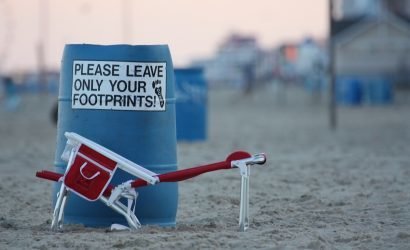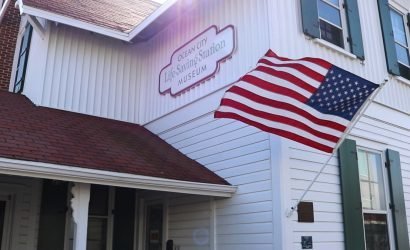The Ocean City Life-Saving Station Museum houses a wonderful collection of coastal artifacts depicting life on the shore in the Ocean City, MD area from the town’s earliest days. Permanent collections include the downstairs Wreck in the Offing exhibit portraying the life-saving techniques used from 1878 to 1914. An apparatus cart, surf-boat, and life-cart are on display, as well as a pictorial history and detailed descriptions of some of the coastal regions most famous ship wrecks.
Upstairs, one can peruse the rooms and visit the Aquarium Room or the Boardwalk of Yesteryear exhibit, complete with long ago souvenirs and a rolling cart once used for travel before the days of the trolley, and Laughing Sal whose boisterous giggle stays with you long after you leave. Davey Jones’ Locker houses a collection of artifacts from coastal shipwrecks including the Andria Doria and the Naval destroyer Jacob Jones, sunk off the coast of Cape Henlopen, Delaware by German U-boats during World War II.
The Museum’s newest exhibit, recently celebrated with a grand opening on International Surfing Day, June 20th, is entitled Surf’s Up!—Riding the Waves of Change, and chronicles the history of surfing in Ocean City, MD.
For many people, the beginning of surfing may well be considered to be the 1960’s when it was made commercially popular by the music of the Beach Boys and the genre of movies including the series of Gidget films and Beach Party featuring Annette Funicello and Frankie Avalon, and those that followed. In reality, popular culture had just caught onto a lifestyle already for decades by those who lived in coastal regions around the world, including Ocean City.
The Surfs Up! exhibit features surfboards, bathing suits, and artifacts from the earliest days of surfing in Ocean City to the present. According to the Museum’s display, surfing essentially began in one form in Ocean City when members of the Fennimore, Baker, and Fox families visiting from Baltimore started “shooting the waves,” or rather, body surfing in 1906. Another part of the Museum’s exhibit, featuring a letter to the editor of The Sunday Sun, attributes the real start of surfing in the area to Watts Smith, a twenty-year-old who had lived in Hawaii, became an expert at surfing, then traveled to Ocean City and taught the locals all he knew in the 1920’s.
| Artifacts like this 1920 surfboard handmade by George Bertrand Cropper of Ocean City help to illustrate the story of surfing in the area. It was built by a plank of pine purchased from a lumber store in Berlin, MD. Originally, the board was 8 feet long, and weighed a whopping 165 pounds! Pine was the lightest option for Cropper. The later preferred balsa wood didn’t become popular in the U.S. until decades later. |
 |
| This surfboard from roughly 50 years later shows the evolution of craftsmanship. This board was shaped by Ocean City local surfer Teddy Gomez, and features artwork by David Lane. It was created for Dale Showell, then owner of the Sundancer Surf Shop. The calligraphy shown depicts lyrics to the song For a Dancer by Jackson Browne. |
 |
| The red jacket here is an authentic Dale Kahanamoku Invitational Team Jacket from 1967. It was gifted to Bill Wise, co-owner of The Eastern Surfer Surf Shop by internationally acclaimed surfer Miki Dora at the competition. Wise and his wife were guests of famous board maker Hobie Alter, who flew then to Hawaii for the competition. The gift was a show of respect for Wise’s knowledge of surfing and show of courage in the face of adversity, after he had been paralyzed in a surfing accident. |
 |
| An early beach patrol uniform and pictorial display of the early days of surfing, and saving in Ocean City, MD |
 |
| This image perfectly captions the quintessential summer scene in Ocean City in the 1960’s. Taken in front of the Castle in the Sand on 37th Street. |
 |
The Ocean City Life-Saving Station Museum is open Memorial Day through Labor Day Tuesdays through Sundays from 10:00am to 10:00pm and Mondays from 10:00am to 5:00pm. All exhibits are included in one price admission. Find out more on the Museum’s website.









